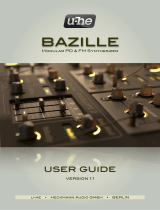Page is loading ...

!
[ OPERATION MANUAL ]!
Updated: 09/12/15

Elements: Distort
Welcome!
Thank you for purchasing Elements: Distort.
Distort is a versatile, warm-sounding stereo EQ and distortion effect, which integrates
seamlessly into our Elements modular series. It combines a freely assignable envelope
follower with a parabolic EQ and waveshaper section, complete with 9 unique distortion
types. In addition, it can plugged into DS-LFO for modular stereo CV manipulation.
Used either as a standalone device or as part of a modular/multiband setup, Distort is an
exceptional creative tool for sound designers and musicians alike.
Typical applications include: Classic distortion effects; dynamic distortion effects; gentle
warming; squealing basses; piercing latex mush; thermonuclear warfare.
We hope you have as much fun using it as we did creating it. Enjoy!
About Elements
Elements is a series of mini devices derived from our Triad Multiband series. They have been
carefully crafted to isolate and enhance specific “elements” of Triad, and integrate together
modularly, through stereo CV modulation and slick, unified design.
Currently available Elements: Chorus, Distort, DS-LFO, Filter, Lo-Fi, Phaser, S-Delay, Splitter!
Page of 1 5

Elements: Distort
Contents
Loading and saving patches
Loading and saving patches in Chorus is done in the same way as with any other Reason
device. See “Loading patches” and “Saving patches” in the Reason Operation Manual for
further information.
Controls and displays
ENV FOLLOWER!
The Env Follower generates a control signal from the device's audio input which can be
applied independently, either positively or negatively, to Distort’s primary controls. This signal
can be “smoothed” using the Attack and Release controls. Immensely tweakable, the Env
Follower produces a dynamic distortion effect, which will follow the flow of the music and help
bring it to life.
Welcome! 1
Loading and saving patches 2
Controls and displays 2
Env Follower 2
Pre-EQ 3
Waveshaper 4
Distortion Types 4
Global 5
Rear Panel 5
Page of 2 5

Elements: Distort
Amp — Controls the amount of envelope modulation applied to the destinations specified by
the individual Envelope Mod Target toggle buttons.
Attack — Controls the attack of the envelope. Higher settings result in a slower attack,
whereas lower settings are much faster.!
Release — Controls the release or decay of the envelope. Higher settings result in a slower
release, whereas lower settings are much faster.
Envelope Mod Targets — Located to the right of the three knob controls listed above, these
buttons toggle whether the envelope modulation gets applied to their respective targets. E.g.,
activating the Freq and Drive buttons ensures that the envelope modulation gets applied to
the Freq and Drive parameters, but not to Boost.
PRE-EQ
EQ Freq — Selects the frequency of the pre-boost, post-cut EQ. Ranges between 30 Hz
and 10 kHz.
EQ Boost — Applies a bell shaped EQ boost to the audio signal before the distortion takes
place, followed by a similarly shaped EQ cut after the distortion. The frequency is controlled
via the EQ Freq knob listed above.
EQ Width — Serves to narrow or widen the EQ boost/cut listed above, leading to a wider
range of sonic effects than can be created.
Page of 3 5

Elements: Distort
WAVESHAPER!
Drive — Acts as a pre-amp, in that it boosts the volume level of the input signal before the
distortion algorithm is applied to the signal.
Distortion Type — Toggles between the 6 different distortion types.
DISTORTION TYPES
Hard Clip — Amplifies and hard-clips the audio signal.
Hyperbolic — Amplifies and the audio signal before running it through a hyperbolic saturator.
Sine — Amplifies and the audio signal before running it through a sinusoidal saturator.
Foldback — Amplifies the audio. Audio signals which exceed the threshold are then reflected
back down in the threshold axis.
Rectify — Inverts negative audio signal values so they become positive, and blends this
signal with a low-pass filtered version of the original signal. Identical to the ‘Rectify’ algorithm
in our Mutagen Rack Extension.
Digital Stomp — A unique kind of digital distortion, perfect for recreating those old-school
video game sound FX of yore.
Hard Rectify — Inverts negative audio signal values so they become positive. Unlike the
‘Rectify’ algorithm described above, this is a “pure” rectifying distortion that gives a
considerably less rubbery sound.
Warmth — A subtle drive control that works identically to the saturation algorithm in our
Relapse Rack Extension, only now with added pre and post-EQ functionality.
Arctan — Amplifies and the audio signal before running it through a arctan saturator.!
Page of 4 5

Elements: Distort
GLOBAL!
Mix — Controls the dry/wet mix of the device.
Vol — Controls the volume level of the device’s output, allowing you to either attenuate it or
boost it by up to 6 decibels.
REAR PANEL!
As with most other devices in our Elements series, Distort offers two distinct types of CV
modulation—mono or stereo—depending on the parameter in question. This is a unique
implementation which truly embraces Reason’s modular concept and allows for effects which
were impossible... until now.
Mono CV modulation — The CV input modulates the parameter for the left and right audio
channel in an identical manner. Essentially, the CV modulation for these parameters works
exactly like it does for any stock Reason device.
Stereo CV modulation (L/R) — The left and right audio channels are modulated are
modulated individually. This works by connecting the left and right CV inputs for the
parameter to separate CV sources (such as the stereo CV outputs of our DS-LFO device, or
indeed any two CV outputs from any Reason device). These parameters also allow for mono
CV modulation, which is active if only the left CV input is connected (in much the same way
that connecting only the left audio input of a stereo pair gives you a mono audio signal).
Page of 5 5
/





